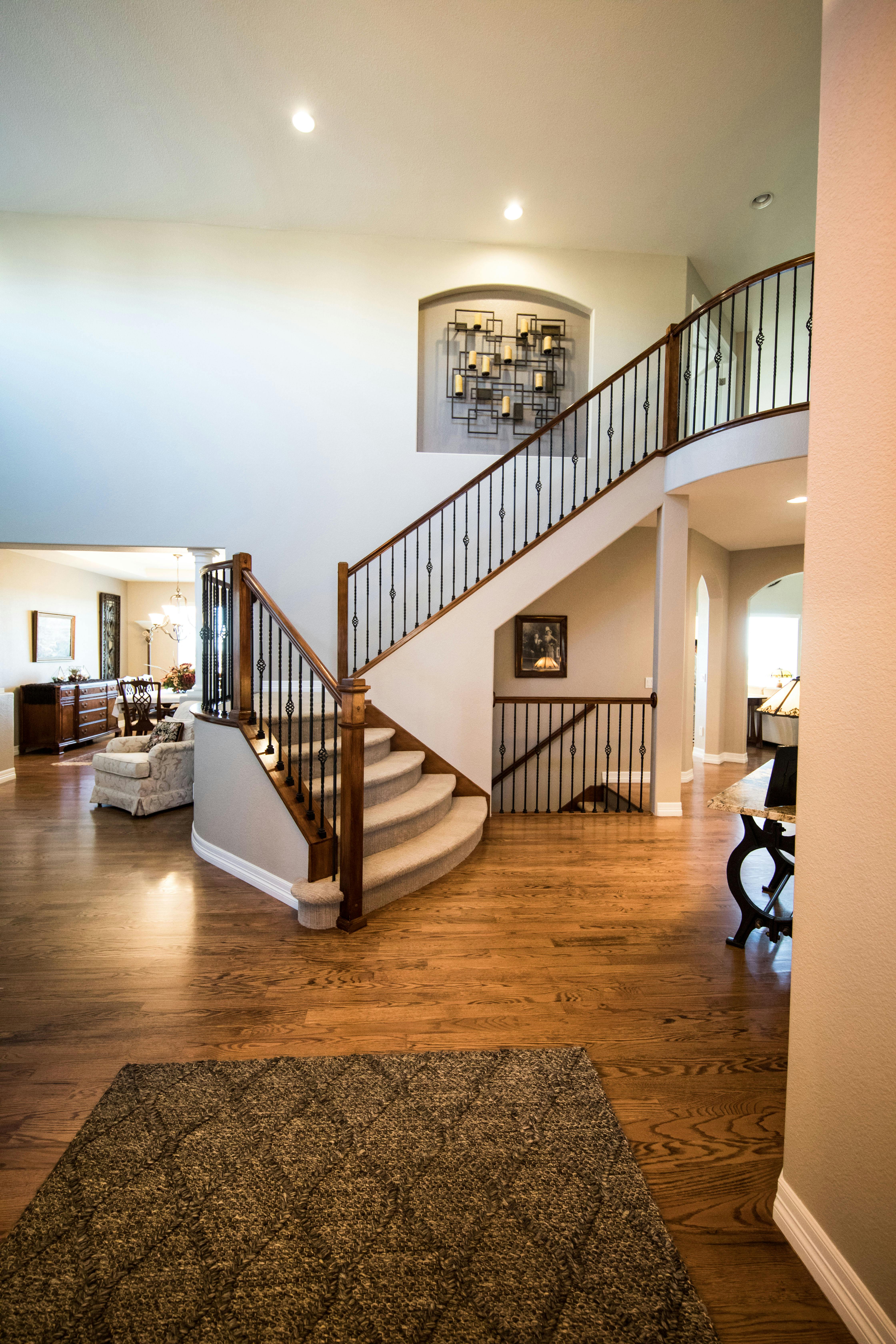For most people, their first home isn’t their dream home. It starts off nice enough. But as time goes by and your family grows, starter homes tend to get a little . . . cramped.
But don’t hate on your current home too much. Because while it gave you a safe and dry place to lay your head at night, it was also setting you up to own your dream home someday.
We’ll show you how it all works and walk you through the steps that’ll get you in your dream home—one you can actually afford!
How to Get Your Dream Home in 5 Steps
Here are the steps:
- Follow the Financial Basics
- Find Out How Much Equity You Have
- Set Your New Home-Buying Budget
- Find the Right Dream Home for You
- Be Picky and Patient
Now let’s cover each step in more detail.
Step 1: Follow the Financial Basics
First thing’s first—you have to get out of debt, get on a budget, and build up an emergency fund of 3–6 months of expenses. Sounds pretty basic, right? If you haven’t completed these steps, then you’re not ready to upgrade to your dream home . . . yet.
Now, when you’ve got house fever, it can be hard to focus on paying off debt or saving an emergency fund before you upgrade your home—especially when you’re feeling the pressure of rising home prices and interest rates.
But whether it’s your second or third house, you should only buy a home when you’ve covered the financial basics we mentioned above. Then you’ll be ready to start the journey toward owning your dream house.
And that journey starts with your home equity. What’s equity? Well, we’re glad you asked . . . that brings us to the next step.
Step 2: Find Out How Much Equity You Have
Home equity is a pretty simple concept: It’s your current home’s value minus whatever you still owe on your mortgage.
See, in most cases, your home’s value increases over time. Similar to other long-term investments (like retirement accounts), homes gradually increase in value. There have been periods of ups and downs in the market to be sure, but the value of real estate has consistently gone up. According to the St. Louis Federal Reserve, the average sale price of a home has increased over 2,300% from 1965 to 2023! And in the last ten years (2013 to 2023), there’s been a 68% increase.1 As your home increases in value, so does your equity. In real estate terms, this is called appreciation.
Other factors that increase your home’s equity include:
- Added value: Home improvement projects like adding square footage, updating fixtures and appliances, or even just slapping on a new coat of paint can add value to your home.
- Mortgage paydown: Paying down your mortgage not only gets you out of debt faster, it also builds your equity. The less you owe on your home, the more equity you have.
The amount of equity you have gives you a pretty good idea of how much money you’ll end up with after selling your house. You can use that money to make a hefty down payment and cover the other costs that come with buying a home.![]()
Find expert agents to help you buy your home.
So, how do you determine your home’s value? Well, you can get a ballpark estimate on real estate websites like Zillow, ask a trusted real estate agent to perform a competitive market analysis (which they’ll do anyway if they’re helping you sell your house), or get a professional appraisal.
Finding out your home’s equity will involve a little math, but it’s third-grade-level stuff, so don’t sweat it.
Here’s what we mean. Let’s say your home’s current value is $355,000. When you sell that house, you’ll have to pay for between 1–3% of the sale price in closing costs, another 6% in fees for the real estate agent who helped you sell it, and whatever’s left to pay off on your mortgage.

That means you can estimate clearing over $223,000 from selling your house. That’s a killer down payment on your dream home! And if your home is paid off, that’s even more money to put down and use to pay for things like repairs and moving expenses.
Step 3: Set Your Dream Home Budget
Once you know how much you’ll clear from the sale of your home, you can start making a budget for your dream home.
The key to owning your dream home (instead of it owning you) is to keep your mortgage payment to no more than 25% of your take-home pay on a 15-year fixed-rate mortgage, along with paying a down payment of at least 20% to avoid private mortgage insurance (PMI). Never get a 30-year mortgage even if the bank offers it (and they will). You’d pay a fortune in interest—money that should go toward building your wealth, not the bank’s.
So, let’s say your take-home pay is $4,800 a month. That means your monthly mortgage payment shouldn’t be any bigger than $1,200. By the way, that 25% figure should also include other home fees collected every month with the mortgage payment like homeowners association (HOA) fees, insurance premiums and property taxes.
Plug your numbers into our mortgage calculator to see how much house you can afford.
And don’t forget to budget for all those other costs that come with the home-buying process in addition to your closing fees—things like moving expenses and any upgrades or repairs you might need to make. You don’t want these hidden costs to catch you off guard or drain your emergency fund.
Step 4: Find the Right Dream Home for You
This is where things get real. After all your hard work building up your equity (and doing a lot of math—don’t forget that), you’re finally ready to start the house hunt. Woo-hoo!
But don’t lose focus. Stay zoned in by making a list of features that make a home fit your budget, lifestyle and dreams—and stick to it throughout your house hunt. Here are a few ideas to get you started.
- Don’t compromise on location and layout. If you plan to be in this home for the long haul, an out-of-the-way neighborhood or a wacky floor plan is a deal breaker. Look for a community and layout that’ll suit your lifestyle now and for years to come.
- Think about how much space your family needs. While your budget has the final say about how much home you buy, you’ll want your dream home to fit your family’s needs through different life seasons.
- Consider the school districts. If you have or want kids, the quality of the nearby school districts is probably already on your mind. But even if you don’t have kids or you’re retired, keep in mind that having good schools nearby could increase your home’s value.
- Look for a house that’ll grow in value. Are home values rising in the area? Is the number of businesses going up? These factors can help you figure out whether your dream home will turn into a good investment.
- Count the costs. Want that fancy master bathroom with the multiple showerheads and the Jacuzzi tub? Be clear on what’s a must-have and what’s nice to have. And don’t forget, upgraded features like that will make your dream home more expensive.
Step 5: Be Picky and Patient
We know you’re anxious to get into those new digs, but be patient. Wait for the right house at the right time. Don’t spend your money on a less-than-ideal home just because you’re tired of looking.
The key is finding a good real estate agent who understands your budget and refuses to settle for “good enough.” They’re as committed to your dream as you are and will have your back throughout the entire process, no matter what it takes.
In addition to teaming up with a great real estate agent, you can take a couple of extra steps to make sure you’re ready to strike as soon as the right home comes up:
- Get preapproved for a 15-year fixed-rate mortgage. Having preapproved financing is a green flag for sellers—especially in multiple offer situations. And because this puts most of your information in the lender’s system, you’ll be on the fast track to closing once your offer is accepted.
- Offer earnest money with your bid. Earnest money is a deposit to show you’re truly interested in a home. Usually it’s 1–2% of the home’s purchase price and it’s applied to your down payment or closing costs. Even if the deal falls through, you can almost always get most of it back.
Find a Real Estate Expert in Your Local Market
Now, you might be thinking you have some work to do before you’re ready to find your dream home. Or you may be realizing your years of hard work are about to pay off! Regardless, if you follow these steps, you’ll find the house you’ve always wanted and avoid a purchase you’ll regret.
Once you’re ready, connect with one of our RamseyTrusted real estate agents. These are high-performing agents who do business the Ramsey way and share your values so you can rest easy knowing the search for your dream home is in the right hands.
Find the only real estate agents in your area we trust, and start the hunt for your dream home!
My Neighbors Called Me & Complained about My In-Laws’ Actions – I Gave Them the Green Light to Put Them in Their Place

Michelle is away when she finds out her in-laws have turned her home into their personal fiefdom. She decides to let her quirky neighbors handle it, and what follows is a hilarious showdown that leaves everyone in stitches and sets the house rules straight. What did Michelle and her neighbors do?
It was a Friday.
David and I sat in our living room, excited about his new project in another state. I work a remote job, so moving to a different state for a short period wasn’t an issue.

A cozy couple at home | Source: Pexels
“I can’t believe we get to start this adventure together,” David said, his eyes shining with enthusiasm.
“Me neither,” I replied, squeezing his hand. “It’s going to be amazing.”
We had called his parents, Miriam and Richard, over to share the news.

An elderly couple using a laptop together | Source: Pexels
When they arrived, I could see the curiosity in their eyes.
“What’s this big news you have for us?” Miriam asked, settling into her favorite chair.
David took a deep breath. “I got the project. We’re moving to California for a month.”
Miriam’s face lit up. “That’s wonderful, David! But what about the house? You can’t just leave it empty.”

The staircase area inside a house | Source: Pexels
Richard nodded. “She’s right. Houses need looking after.”
I glanced at David, who gave me a reassuring smile. “We were hoping you could help with that,” he said.
Miriam’s eyes sparkled with excitement. “Oh, we’d love to! Right, Richard?”
“Absolutely,” Richard agreed.

A senior man sitting on the couch at home | Source: Pexels
“Thank you so much,” I said. “That would be very helpful.”
David seemed relieved. “Great, it’s settled then.”
But as we started to pack up our things, I couldn’t shake the feeling of unease.
Miriam and Richard had a habit of overstepping boundaries, and I worried about what they might do while we were away.

A worried woman sitting on the floor | Source: Pexels
The next morning, David and I loaded the last of our bags into the car. Miriam and Richard stood by, ready to take over.
“Don’t worry about a thing,” Miriam said. “We’ve got it all under control.”
I forced another smile. “Thanks, Miriam. We really appreciate it.”
David hugged his parents goodbye. “Take care of yourselves and the house,” he said.

A young couple exchanging hugs with elderly couple | Source: Pexels
Richard gave me a firm handshake. “You two enjoy your adventure. We’ll keep everything in order here.”
As we drove away, I couldn’t help but feel a knot in my stomach. “Are you sure this is a good idea?” I asked David.
“It’ll be fine, Michelle,” he said, glancing at me. “They mean well.”

A person driving a car | Source: Pexels
I nodded, trying to convince myself. “I know. It’s just…”
“I understand,” he said, squeezing my hand. “But this is a great opportunity for us. And we’re going to enjoy our time in California, okay?”
I took a deep breath and pushed my worries aside. “You’re right. Let’s focus on the adventure ahead.”

A couple travelling in a car | Source: Pexels
But despite my efforts to focus on our new adventure, the unease from leaving our house in Miriam and Richard’s hands lingered.
A week into our stay in California, I received a call from Alice, our close neighbor.
“Hey, Michelle,” Alice started, her voice hesitant. “I need to tell you something about your in-laws.”
My heart sank. “What did they do, Alice?”

A worried woman on a phone call | Source: Pexels
She took a deep breath. “Miriam threw away your purple curtains.”
“What?” I felt a surge of anger. “Those were my favorite!”
“There’s more,” Alice continued. “She also scolded me for wearing a top and shorts in my own backyard.”
I clenched my fist. “That’s so intrusive. She has no right!”

A comfy bedroom | Source: Unsplash
“And,” Alice hesitated again, “I saw her throwing away some of your clothes.”
Chills ran down my spine. “What? She did what?”
“I’m so sorry, Michelle. Tom and I want to help. We can talk to Miriam and Richard and put them in their place.”

Heap of clothes and fabric | Source: Pexels
I took a deep breath, trying to calm my racing heart. “Thank you, Alice. I appreciate it. Please, do what you can. They need to understand boundaries.”
“What’s wrong?” David asked as he entered the room.
“Miriam threw away my curtains and some of my clothes. She even scolded Alice for her outfit in her own yard.”
“What? Mom did that? This is too much. We need to call them.”

A stressed man on the couch | Source: Pexels
“Let’s wait,” I said. “Alice and Tom are going to talk to them first.”
“Alright, but if this doesn’t stop, we’re calling them ourselves.”
“They need to learn that they can’t just do whatever they want,” I said, nodding.
As I ended the call with Alice, I felt a sense of resolve. Miriam and Richard were going to learn the hard way that their behavior was unacceptable.

A woman holding a phone | Source: Pexels
I anxiously waited for Alice’s call to update me on their talk with Miriam and Richard. When my phone finally rang, I answered immediately.
“Michelle, it’s Alice. We talked to them, but Miriam just brushed it off. We need to take this further.”
I took a deep breath. “Alright, what’s the plan?”
“We’ll gather the neighbors,” Alice said. “Let’s have a video call to discuss it.”

A woman lying on the sofa and holding her phone | Source: Pexels
An hour later, I sat at my laptop, connecting to a video call with Alice, Tom, Brian, Ellen, and Honor. Everyone looked serious and ready to help.
“Thanks for joining,” I began. “Miriam’s crossed the line. We need to show her boundaries.”
Brian nodded. “What can we do?”
Alice leaned in. “Miriam’s planning a barbecue this weekend. I say we crash it.”

Hotdogs on a grill | Source: Pexels
Tom grinned. “Sounds good. How?”
“Everyone wears Hawaiian shorts,” Alice suggested, her eyes twinkling. “And we bring tuna pies — Miriam hates them.”
Ellen laughed. “That’ll definitely make a statement.”
“Make it fun and loud,” I added, feeling a mix of excitement and nerves. “Show them what real boundaries are.”
Honor nodded. “Count me in.”

A person in floral printed attire | Source: Pexels
We spent the next hour planning every detail. Everyone had a role, from baking the pies to finding the brightest Hawaiian shorts!
Before we ended the call, Brian clapped his hands together. “This is going to be epic.”
“Remember,” I said, trying to sound confident, “the goal is to reclaim my home, not start a war.”
Alice smiled. “We’ve got this, Michelle. They won’t know what hit them.”

A smiling woman on a video call | Source: Pexels
Just when I hung up, David returned from grocery shopping. “We have a plan,” I explained, detailing everything.
He listened quietly and sighed. “I feel bad it’s come to this. They’re my parents, after all.”
“I know,” I said gently. “But they need to learn they can’t do whatever they want.”
He nodded slowly. “You’re right. I just wish it didn’t have to be this way.”

A couple chilling at home | Source: Pexels
“I understand,” I replied. “But it’s the only way to reclaim our home.”
David managed a small smile. “Alright. Let’s see how it goes.”
That weekend, I traveled back home, determined to handle the situation in person.

A woman driving | Source: Pexels
Soon, the day of the barbecue arrived, and Miriam’s loud invitations gave Alice the perfect opportunity to overhear. I waited anxiously nearby, ready for the call.
Soon enough, my phone rang. “Michelle, they’re here,” Honor said. “It’s time.”
“On my way,” I replied, taking a deep breath and heading to our backyard.

A woman on a phone call | Source: Pexels
As I approached, I saw the neighbors in their bright Hawaiian shorts, carrying tuna pies and ready to party. Miriam and Richard stood there, shocked and outraged.
“What is this? You can’t be here!” Miriam snapped at them.
Alice stepped forward, unfazed. “We’re here to enjoy the barbecue, Miriam.”
Miriam’s face turned red. “I’m calling the police! You can’t just crash my party like that.”

An angry elderly woman | Source: Pexels
Honor quickly called me. “Michelle, it’s time.”
I entered the backyard, feeling a surge of determination. “Miriam,” I began, “you’ve crossed the line. So I think I should be the one calling the cops.”
Miriam glared at me. “How dare you speak to me like this in front of everyone! This is unacceptable! Did you plan all of this?”

Two cops | Source: Pexels
“Unacceptable,” I said firmly, “is you changing the curtains, making inappropriate remarks to my neighbors, and throwing away my clothes! My neighbors will stay at this party, and you will serve them barbecue. Then, you’ll pay me for the things you threw away. Otherwise, I’ll call the police for damaging my property at MY home.”
Miriam’s facade crumbled as she stood speechless, her face red with anger and disbelief.
“You can’t do this,” she sputtered.

An angry senior woman in gray clothes | Source: Midjourney
“You have a choice,” I said, holding my ground. “Comply or face the consequences.”
The neighbors watched, some smiling, others nodding in agreement. Richard, realizing the gravity of the situation, gently tugged her arm.
“We should just do what she says,” Richard said quietly. “Let’s not make this worse.”

A sad elderly man | Source: Pexels
Miriam looked around, seeing the determination on my face and the support from the neighbors. She finally nodded, defeated. “Fine,” she muttered.
With no choice, Miriam served the barbecue with a forced smile while the neighbors enjoyed the party. The atmosphere was lively and joyous, with music playing and everyone having a good time.
I was glad that I had reclaimed my home and set the boundaries clear. It wasn’t just about the curtains or the clothes — it was about respect and understanding. And we had made that crystal clear.

An elderly woman serving food | Source: Midjourney
Do you think we did the right thing?
If you enjoyed this story, here’s another one about how a heroic act by a young boy brought a positive change in the lives of many.
This work is inspired by real events and people, but it has been fictionalized for creative purposes. Names, characters, and details have been changed to protect privacy and enhance the narrative. Any resemblance to actual persons, living or dead, or actual events is purely coincidental and not intended by the author.
The author and publisher make no claims to the accuracy of events or the portrayal of characters and are not liable for any misinterpretation. This story is provided “as is,” and any opinions expressed are those of the characters and do not reflect the views of the author or publisher.



Leave a Reply